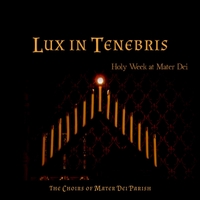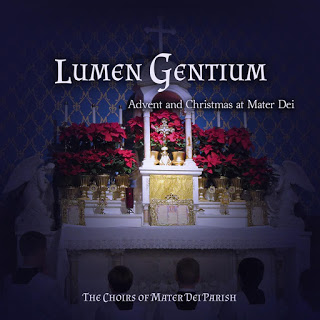This year, Good Friday fell on March 25, the day on which the Church usually celebrates the Feast of the Annunciation. The feast is moved because it lands on Good Friday (Good Friday taking precedence even over the solemnity), but the significance of the confluence of these two events on the same day is surreal. At least, I found it so. One tradition holds that March 25 was the actual day of Good Friday, that the Lord was conceived and died on the same day of the year. I’m often quite emotional during Holy Week as it is, but I felt the unusual occurrence of the Annuncation on Good Friday elicit an even greater response from me than usual. Call time was at 2:15 for the choir on Good Friday, so I had some time in the morning to get started on a new composition: a setting of the Angelus.
The Angelus
Background
As in 2014, when I felt particularly moved to write polyphonic settings of Christus Factus Est and Et Valde Mane, I sat down on March 25 specifically to write a setting of the Angelus. After setting the first line to chant, I went to work on the main theme. With an hour or so to spare before call time, I had something in six parts written down, and I liked it well enough to play back over and over again. I would have to leave it until Holy Saturday, as we had the Solemn Afternoon Liturgy (at which we got to sing Lotti’s 8-part Crucifixus — wow!) followed by Tenebrae that evening.
Holy Saturday is unique. There is both the heartache of what happened the day before and the anticipation of Easter. The disciples are hiding in the upper room, and I feel as if I am in shock. But call time was not until 9:45 PM, so I had all day to work on the Angelus before dinner with some of the extended family. I always look forward to the consecration at the Easter Vigil (the Mass of the Easter Vigil is technically on Easter Sunday). I feel I can say with the holy women, “We have seen the Lord.”
I finished the piece on Easter Sunday, save for minor changes and a suggestion from our choir director to make the ending more full by adding two extra notes in the tenor line.
Discussion
This piece is the first I’ve written in six parts, the parts being Soprano, Mezzo-Soprano, Alto, Tenor, Baritone, and Bass. The range is significant, with the Bass having an optional low D and the first Soprano having a single, high B at the climax of the piece. Otherwise, the range is more generally confined to a G in the Bass through a G in the Soprano.
As with Ave Maria, I tried to maintain a Renaissance sound and confined myself to the key of D major with only brief transitions to A major (there are, of course, other chords in the piece, but only G# as an accidental). Each cadence ends either on D major or A major.
I think it is correct to say that this piece is based around Mode VI. The main theme is at least reminiscent of the Gloria Patri (or any psalm I suppose) sung in Mode VI.
The time signature for the piece is unusual, I’ll grant. The idea is to direct only the down beat of each measure with the intention of producing an “etherial” tempo, beat in one.
Angelus Domini Nunciavit Mariae
The opening line is chanted and slightly embellishes Mode VI. Sung by the Baritone voice, the line considers the Angel Gabriel speaking to Mary. The text at this point, of course, is a narration: “The Angel of the Lord declared unto Mary”. After a pause, the choir enters.
Et Concepit de Spiritu Sancto
Choosing a climax for the Angelus is not, in my opinion, obvious. “And she conceived of the Holy Spirit” is certainly climactic. Yet its meaning is essentially the same as “And the Word became Flesh”. Both are speaking of the same event. One could argue quite validly that the latter phrase is the climax, as we genuflect there.
I ended up setting both “Et concepit de Spiritu Sancto” and “Et Verbum caro factum est” to the main theme, given their similitude. Where then is the climax?
Ecce Ancilla Domini
At the words “Behold the handmaid of the Lord” the text is no longer a narration. These words are a direct quote, and they are spoken by Mary. The second theme, then introduces a four part choir of female voices, a contralto essentially taking the tenor line. All the male voices are silent. The time signature also briefly changes to 2:2, although there is no acceleration or deceleration in tempo.
On this passage, the ladies’ choir should aim for sweetness, swelling into the rising notes of “Domini” and ending very gently.
Fiat Mihi Secundum Verbum Tuum
I decided this would be the climax of the piece. Surely, you may be asking, the climax should be “Et Verbum caro factum est.” You may well be right, but my reasoning is that “Et concepit de Spiritu Sancto” and “Et Verbum caro factum est” are the effects. “Fiat mihi secundum verbum tuum” was the cause, the consent, the act of will that it should be done. This was the action of tremendous faith and resignation on the part of Mary, though she was the passive actor. Here is the unfathomable humility of the Trinity, God subjecting Himself and the work of the redemption to the will of one of His creatures.
After the gentle ending of “Ecce ancilla Domini”, all six voices return with strength on that word “Fiat”, gradually tapering down until the soft, homophonic, resigned “secundum verbum tuum”.
In this passage, the Soprano soars to a high B, with the baritone imitating. The Mezzo-Soprano sings against the Soprano, while the other voices are more stretched out, forming the foundation of the chords. At “secundum”, there is very little motion, and all the voices should project above all a spirit of resignation.
Et Verbum Caro Factum Est Et Habitavit in Nobis
Here, we repeat the main theme, which I think is fitting since these words point to the same event as “Et concepit de Spiritu Sancto”. This is not to downplay the words by any means. I like the main theme a lot. I hope it is very moving. The main theme is, I think, more contemplative in its sound than the climax.
Amen
Where is “Ora pro nobis Sancta Dei Genitrix?” you might ask. Just as the Ave Maria is not set between the verses (although, I suppose there is nothing stopping anyone from singing Ave Maria), I felt this final line was more attached to the ending prayer of the Angelus than to the images and ideas that the rest of the prayer presents to our minds.
To end the piece, I borrowed from the “Fiat”, toned it down, and paired it with “Amen”. The word “Amen” is similar in meaning, it would seem, to the word “Fiat”.
Gloria Patri
I made sure to end the Angulus setting with Amen. Yet I did not feel that the piece was complete without adding a verse of thanksgiving, some response we can make to the Lord for this greatest of gifts.
The Gloria Patri chant is taken directly from the Mode VI Gloria Patri (sung e.g., with Mode VI Introits). The final words “et in saecula saeculorum Amen” are sung to the main theme. The Gloria Patri, however, should be omitted if the piece is sung during Passiontide.
Digital Rendering
Final Thoughts
I always welcome feedback so please leave a comment with your thoughts or suggestions. If your choir is interested in singing this piece or any of my compositions, the sheet music is free to download and copy; and I wouldn’t mind at all if you drop a note in the comment box to promote your choir. There is nothing a composer likes more than to know his music is being sung.
The score is released under this Creative Commons license.
About the Featured Image
The featured image is Madonna of the Annunciation by Pompeo Batoni. It is in the public domain.






To whom it may concern,
My name is Fr. Stephen Arabadjis. I am a member of the Society of St. Pius X. But I am in my 7th year of Sabbatical.
Therefore I was hoping your group could do a 54 day rosary novena for my intentions. But any prayers and sacrifices would be greatly appreciated. I know Our Lady will reward you generously for this.
In Our Lady,
Fr. Arabadjis
P.S. Thanking you in advance, since I don’t always get all my communications.
Hello, Father. I don’t really have a group, but my family would be happy to pray for your intentions. May God bless you.